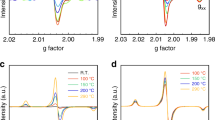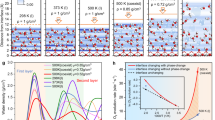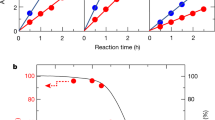Abstract
As the bottleneck in photocatalytic water splitting, the oxygen evolution reaction (OER) has drawn huge attention, but its efficiency still falls short of expectations. A widely accepted speculation is that the catalysts’ activity is insufficient (high reaction barriers need to be overcome). Here, we develop a first-principles method to investigate the photocatalytic OER at the water/TiO2(110) interface. A full mechanism uncovering the importance of radicals is determined. Kinetic analysis further enables to quantitatively estimate each possible obstacle in the process. We demonstrate unambiguously that the rate-determining factor of the OER varies with the concentration of surface-reaching photoholes (Ch+). Under experimental conditions, the intrinsic catalytic activity of TiO2(110) does not represent the main obstacle, but all steps involving the photoholes are slow due to their low concentrations. This suggests that the key to enhance the OER efficiency is to increase Ch+ before Ch+ reaches the estimated threshold (Ch+ = ~10−4).
This is a preview of subscription content, access via your institution
Access options
Access Nature and 54 other Nature Portfolio journals
Get Nature+, our best-value online-access subscription
$29.99 / 30 days
cancel any time
Subscribe to this journal
Receive 12 digital issues and online access to articles
$119.00 per year
only $9.92 per issue
Buy this article
- Purchase on Springer Link
- Instant access to full article PDF
Prices may be subject to local taxes which are calculated during checkout





Similar content being viewed by others
References
Chen, X., Shen, S., Guo, L. & Mao, S. S. Semiconductor-based photocatalytic hydrogen generation. Chem. Rev. 110, 6503–6570 (2010).
Thompson, T. L. & Yates, J. T. Jr Surface science studies of the photoactivation of TiO2-new photochemical processes. Chem. Rev. 106, 4428–4453 (2006).
Nozik, A. J. Photoelectrolysis of water using semiconducting TiO2 crystals. Nature 257, 383–386 (1975).
Salvador, P. & Decker, F. On the generation of H2O2 during water photoelectrolysis at n-TiO2. J. Phys. Chem. 88, 6116–6120 (1984).
Nakamura, R. & Nakato, Y. Primary intermediates of oxygen photoevolution reaction on TiO2 (rutile) particles, revealed by in situ FTIR absorption and photoluminescence measurements. J. Am. Chem. Soc. 126, 1290–1298 (2004).
Cai, R. X., Kubota, Y. & Fujishima, A. Effect of copper ions on the formation of hydrogen peroxide from photocatalytic titanium dioxide particles. J. Catal. 219, 214–218 (2003).
Nakamura, R., Okamura, T., Ohashi, N., Imanishi, A. & Nakato, Y. Molecular mechanisms of photoinduced oxygen evolution, PL emission, and surface roughening at atomically smooth (110) and (100) n-TiO2 (rutile) surfaces in aqueous acidic solutions. J. Am. Chem. Soc. 127, 12975–12983 (2005).
Imanishi, A., Okamura, T., Ohashi, N., Nakamura, R. & Nakato, Y. Mechanism of water photooxidation reaction at atomically flat TiO2 (rutile) (110) and (100) surfaces: dependence on solution pH. J. Am. Chem. Soc. 129, 11569–11578 (2007).
Chen, J., Li, Y. F., Sit, P. & Selloni, A. Chemical dynamics of the first proton-coupled electron transfer of water oxidation on TiO2 anatase. J. Am. Chem. Soc. 135, 18774–18777 (2013).
Zhao, W. N. & Liu, Z. P. Mechanism and active site of photocatalytic water splitting on titania in aqueous surroundings. Chem. Sci. 5, 2256–2264 (2014).
Li, Y. F., Liu, Z. P., Liu, L. & Gao, W. Mechanism and activity of photocatalytic oxygen evolution on titania anatase in aqueous surroundings. J. Am. Chem. Soc. 132, 13008–13015 (2010).
Valdés, A., Qu, Z. W., Kroes, G. J., Rossmeisl, J. & Nørskov, J. K. Oxidation and photo-oxidation of water on TiO2 surface. J. Phys. Chem. C 112, 9872–9879 (2008).
Cheng, J., Liu, X., Kattirtzi, J. A., VandeVondele, J. & Sprik, M. Aligning electronic and protonic energy levels of proton-coupled electron transfer in water oxidation on aqueous TiO2. Angew. Chem. Int. Ed. 53, 12046–12050 (2014).
Cho, I. S. et al. Codoping titanium dioxide nanowires with tungsten and carbon for enhanced photoelectrochemical performance. Nat. Commun. 4, 1723 (2013).
Gai, Y., Li, J., Li, S. S., Xia, J. B. & Wei, S. H. Design of narrow-gap TiO2: a passivated codoping approach for enhanced photoelectrochemical activity. Phys. Rev. Lett. 102, 036402 (2009).
Asahi, R., Morikawa, T., Ohwaki, T., Aoki, K. & Taga, Y. Visible-light photocatalysis in nitrogen-doped titanium oxides. Science 293, 269–271 (2001).
Zhang, J., Xu, Q., Feng, Z., Li, M. & Li, C. Importance of the relationship between surface phases and photocatalytic activity of TiO2. Angew. Chem. Int. Ed. 47, 1766–1769 (2008).
Wang, X. et al. Photocatalytic overall water splitting promoted by an α-β phase junction on Ga2O3. Angew. Chem. Int. Ed. 51, 13089–13092 (2012).
Zhao, W.-N., Zhu, S.-C., Li, Y.-F. & Liu, Z.-P. Three-phase junction for modulating electron-hole migration in anatase–rutile photocatalysts. Chem. Sci. 6, 3483–3494 (2015).
Schaub, R. et al. Oxygen vacancies as active sites for water dissociation on rutile TiO2(110). Phys. Rev. Lett. 87, 266104 (2001).
Aschauer, U. et al. Influence of subsurface defects on the surface reactivity of TiO2: water on anatase (101). J. Phys. Chem. C 114, 1278–1284 (2010).
Maeda, K. Direct splitting of pure water into hydrogen and oxygen using rutile titania powder as a photocatalyst. Chem. Commun. 49, 8404–8406 (2013).
Abe, R., Sayama, K. & Sugihara, H. Development of new photocatalytic water splitting into H2 and O2 using two different semiconductor photocatalysts and a shuttle redox mediator IO3 -/I-. J. Phys. Chem. B 109, 16052–16061 (2005).
Zhang, H., Chen, G. & Bahnemann, D. W. Photoelectrocatalytic materials for environmental applications. J. Mater. Chem. 19, 5089–5121 (2009).
Kafizas, A., Carmalt, C. J. & Parkin, I. P. Does a photocatalytic synergy in an anatase-rutile TiO2 composite thin-film exist? Chem. Eur. J. 18, 13048–13058 (2012).
Cheng, J., Sulpizi, M., VandeVondele, J. & Sprik, M. Hole localization and thermochemistry of oxidative dehydrogenation of aqueous rutile TiO2(110). ChemCatChem 4, 636–640 (2012).
Wang, D., Wang, H. & Hu, P. Identifying the distinct features of geometric structures for hole trapping to generate radicals on rutile TiO2(110) in photooxidation using density functional theory calculations with hybrid functional. Phys. Chem. Chem. Phys. 17, 1549–1555 (2015).
Wang, D., Liu, Z.-P. & Yang, W. Proton promoted electron transfer in photocatalysis: key step for photocatalytic hydrogen evolution on metal/titania composites. ACS Catal. 7, 2744–2752 (2017).
Wood, B. C., Schwegler, E., Choi, W. I. & Ogitsu, T. Hydrogen-bond dynamics of water at the interface with InP/GaP(001) and the implications for photoelectrochemistry. J. Am. Chem. Soc. 135, 15774–15783 (2013).
Wood, B. C., Schwegler, E., Choi, W. I. & Ogitsu, T. Surface chemistry of GaP(001) and InP(001) in contact with water. J. Phys. Chem. C 118, 1062–1070 (2014).
Bullard, J. W. & Cima, M. J. Orientation dependence of the isoelectric point of TiO2 (rutile) surfaces. Langmuir 22, 10264–10271 (2006).
Sun, C. H., Liu, L. M., Selloni, A., Lu, G. Q. & Smith, S. C. Titania-water interactions: a review of theoretical studies. J. Mater. Chem. 20, 10319–10334 (2010).
Marx, D. Proton transfer 200 years after von Grotthuss: insights from ab initio simulations. ChemPhysChem 7, 1848–1870 (2006).
Thompson, T. L. & Yates, J. T. Monitoring hole trapping in photoexcited TiO2(110) using a surface photoreaction. J. Phys. Chem. B 109, 18230–18236 (2005).
Cheng, J., VandeVondele, J. & Sprik, M. Identifying trapped electronic holes at the aqueous TiO2 interface. J. Phys. Chem. C 118, 5437–5444 (2014).
Micic, O. I., Zhang, Y., Cromack, K. R., Trifunac, A. D. & Thurnauer, M. C. Trapped holes on titania colloids studied by electron paramagnetic resonance. J. Phys. Chem. 97, 7277–7283 (1993).
Kafizas, A. et al. Water oxidation kinetics of accumulated holes on the surface of a TiO2 photoanode: a rate law analysis. ACS Catal. 7, 4896–4903 (2017).
Le Formal, F. et al. Rate law analysis of water oxidation on a hematite surface. J. Am. Chem. Soc. 137, 6629–6637 (2015).
Li, Y. F. & Selloni, A. Theoretical study of interfacial electron transfer from reduced anatase TiO2(101) to adsorbed O2. J. Am. Chem. Soc. 135, 9195–9199 (2013).
Wang, D., Jiang, J., Wang, H.-F. & Hu, P. Revealing the volcano-shaped activity trend of triiodide reduction reaction: a DFT study coupled with microkinetic analysis. ACS Catal. 6, 733–741 (2015).
Hansen, H. A., Viswanathan, V. & Nørskov, J. K. Unifying kinetic and thermodynamic analysis of 2e– and 4e– reduction of oxygen on metal surfaces. J. Phys. Chem. C 118, 6706–6718 (2014).
Stegelmann, C., Andreasen, A. & Campbell, C. T. Degree of rate control: how much the energies of intermediates and transition states control rates. J. Am. Chem. Soc. 131, 8077–8082 (2009).
Deskins, N. A. & Dupuis, M. Intrinsic hole migration rates in TiO2 from density functional theory. J. Phys. Chem. C 113, 346–358 (2009).
Migani, A. & Blancafort, L. What controls photocatalytic water oxidation on rutile TiO2(110) under ultra-high-vacuum conditions? J. Am. Chem. Soc. 139, 11845–11856 (2017).
Connor, P. A., Dobson, K. D. & McQuillan, A. J. Infrared spectroscopy of the TiO2/aqueous solution interface. Langmuir 15, 2402–2408 (1999).
Tamaki, Y. et al. Dynamics of efficient electron-hole separation in TiO2 nanoparticles revealed by femtosecond transient absorption spectroscopy under the weak-excitation condition. Phys. Chem. Chem. Phys. 9, 1453–1460 (2007).
Rothenberger, G., Moser, J., Gratzel, M., Serpone, N. & Sharma, D. K. Charge carrier trapping and recombination dynamics in small semiconductor particles. J. Am. Chem. Soc. 107, 8054–8059 (1985).
Hu, S. et al. Amorphous TiO2 coatings stabilize Si, GaAs, and GaP photoanodes for efficient water oxidation. Science 344, 1005–1009 (2014).
Kresse, G. & Furthmüller, J. Efficiency of ab-initio total energy calculations for metals and semiconductors using a plane-wave basis set. Comp. Mater. Sci. 6, 15–50 (1996).
Kresse, G. & Hafner, J. Ab initio molecular-dynamics simulation of the liquid-metal–amorphous-semiconductor transition in germanium. Phys. Rev. B 49, 14251–14269 (1994).
Sprik, M. & Ciccotti, G. Free energy from constrained molecular dynamics. J. Chem. Phys. 109, 7737 (1998).
Carloni, P., Sprik, M. & Andreoni, W. Key steps of the cis-platin-DNA interaction: density functional theory-based molecular dynamics simulations. J. Phys. Chem. B 104, 823–835 (2000).
Bucko, T. Ab initio calculations of free-energy reaction barriers. J. Phys. Condens. Matter 20, 064211 (2008).
Song, T. & Hu, P. Insight into the solvent effect: a density functional theory study of cisplatin hydrolysis. J. Chem. Phys. 125, 091101 (2006).
Liu, L. M., Laio, A. & Michaelides, A. Initial stages of salt crystal dissolution determined with ab initio molecular dynamics. Phys. Chem. Chem. Phys. 13, 13162–13166 (2011).
Acknowledgements
D.W. thanks the Chinese Scholarship Council for financial support for living abroad and P.H. thanks the Chinese Government for support from the “Thousands Talents” program. This work was financially supported by National Natural Science Foundation of China (21333003, 21421004, 21622305), Young Elite Scientist Sponsorship Program by the China Association for Science and Technology (YESS20150131), The Shanghai ShuGuang project (17SG30), and the Fundamental Research Funds for the Central Universities (WJ616007).
Author information
Authors and Affiliations
Contributions
P.H. and H.-F.W. conceived the project and contributed to the design of the calculations and analyses of the data. D.W. carried out most of the calculations and wrote the first draft of the paper. T.S. and D.W. conducted the tests of the MPA-MD method. J.C. wrote the kinetic code and contributed to the analyses of data. All the authors discussed the results and commented on the manuscript.
Corresponding authors
Ethics declarations
Competing interests
The authors declare no competing interests.
Additional information
Publisher’s note: Springer Nature remains neutral with regard to jurisdictional claims in published maps and institutional affiliations.
Supplementary information
Supplementary Material
Supplementary Notes 1–8; Supplementary Figures 1–7; Supplementary Tables 1–5
Rights and permissions
About this article
Cite this article
Wang, D., Sheng, T., Chen, J. et al. Identifying the key obstacle in photocatalytic oxygen evolution on rutile TiO2. Nat Catal 1, 291–299 (2018). https://doi.org/10.1038/s41929-018-0055-z
Received:
Accepted:
Published:
Issue Date:
DOI: https://doi.org/10.1038/s41929-018-0055-z
This article is cited by
-
Bubble-water/catalyst triphase interface microenvironment accelerates photocatalytic OER via optimizing semi-hydrophobic OH radical
Nature Communications (2024)
-
Editable semiconductor photo-electrodes for sustainable ammonia synthesis
Nano Research (2024)
-
Facilitating two-electron oxygen reduction with pyrrolic nitrogen sites for electrochemical hydrogen peroxide production
Nature Communications (2023)
-
Gradient tungsten-doped Bi3TiNbO9 ferroelectric photocatalysts with additional built-in electric field for efficient overall water splitting
Nature Communications (2023)
-
Implanting HxYO2−x sites into Ru-doped graphene and oxygen vacancies for low-overpotential alkaline hydrogen evolution
NPG Asia Materials (2023)



